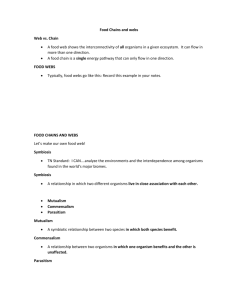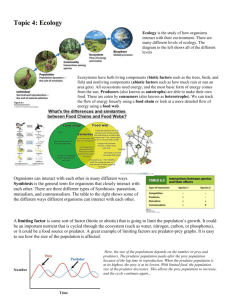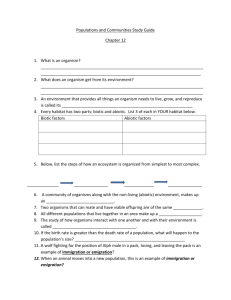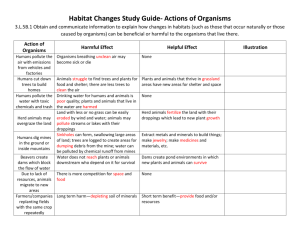10-6-2014 Science
advertisement
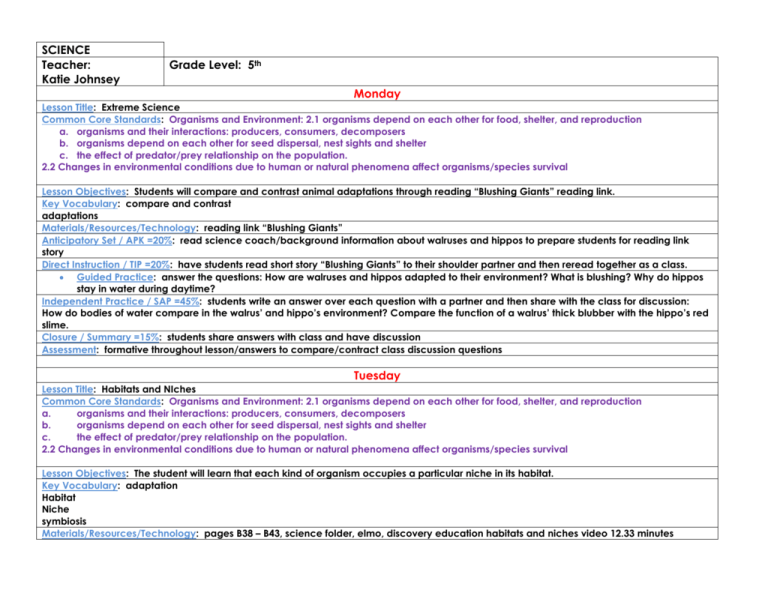
SCIENCE Teacher: Katie Johnsey Grade Level: 5th Monday Lesson Title: Extreme Science Common Core Standards: Organisms and Environment: 2.1 organisms depend on each other for food, shelter, and reproduction a. organisms and their interactions: producers, consumers, decomposers b. organisms depend on each other for seed dispersal, nest sights and shelter c. the effect of predator/prey relationship on the population. 2.2 Changes in environmental conditions due to human or natural phenomena affect organisms/species survival Lesson Objectives: Students will compare and contrast animal adaptations through reading “Blushing Giants” reading link. Key Vocabulary: compare and contrast adaptations Materials/Resources/Technology: reading link “Blushing Giants” Anticipatory Set / APK =20%: read science coach/background information about walruses and hippos to prepare students for reading link story Direct Instruction / TIP =20%: have students read short story “Blushing Giants” to their shoulder partner and then reread together as a class. Guided Practice: answer the questions: How are walruses and hippos adapted to their environment? What is blushing? Why do hippos stay in water during daytime? Independent Practice / SAP =45%: students write an answer over each question with a partner and then share with the class for discussion: How do bodies of water compare in the walrus’ and hippo’s environment? Compare the function of a walrus’ thick blubber with the hippo’s red slime. Closure / Summary =15%: students share answers with class and have discussion Assessment: formative throughout lesson/answers to compare/contract class discussion questions Tuesday Lesson Title: Habitats and NIches Common Core Standards: Organisms and Environment: 2.1 organisms depend on each other for food, shelter, and reproduction a. organisms and their interactions: producers, consumers, decomposers b. organisms depend on each other for seed dispersal, nest sights and shelter c. the effect of predator/prey relationship on the population. 2.2 Changes in environmental conditions due to human or natural phenomena affect organisms/species survival Lesson Objectives: The student will learn that each kind of organism occupies a particular niche in its habitat. Key Vocabulary: adaptation Habitat Niche symbiosis Materials/Resources/Technology: pages B38 – B43, science folder, elmo, discovery education habitats and niches video 12.33 minutes Anticipatory Set / APK =20%: do WW acticity to intro new vocab then put in to folder science folder with main idea statement. Direct Instruction / TIP =20%: orally read lesson 1 page 38-43 Guided Practice: answer the questions: How is a niche like a position on a sports team? And “describe your habitat. Which things in your habitat help you to survive?” Independent Practice / SAP =45%: watch vide habitats and niches from DE Closure / Summary =15%: compare and contrast habitats and niches in a statement on the board produced collectively by the class with teacher guidance Assessment: formative throughout lesson Monitor or Adjust: as needed through observation during lesson Wednesday Lesson Title: habitats and Niches cont Common Core Standards: Organisms and Environment: 2.1 organisms depend on each other for food, shelter, and reproduction a. organisms and their interactions: producers, consumers, decomposers b. organisms depend on each other for seed dispersal, nest sights and shelter c. the effect of predator/prey relationship on the population. 2.2 Changes in environmental conditions due to human or natural phenomena affect organisms/species survival Lesson Objectives: The student will learn that each kind of organism occupies a particular niche in its habitat. Key Vocabulary: adaptation Habitat Niche symbiosis Materials/Resources/Technology: SGA, SGB, science folder, WW, compare and contrast graphic organizer Anticipatory Set / APK =20%: review new vocab doing WW chants and rereading main idea from folder Direct Instruction / TIP =20%: fill in compare and contrast graphic organizer together Guided Practice: students reread the lesson with a partner then complete SGB in their group Independent Practice / SAP =45%: SGA What are habitats and niches? Closure / Summary =15%: students place visual summary in to folder with teacher guidance Assessment: teacher will check folder and check main idea, vocab and visual summary over lesson 1 Monitor or Adjust: Thursday Lesson Title: What factors affect ecosystems? Lesson 2 Common Core Standards: Organisms and Environment: 2.1 organisms depend on each other for food, shelter, and reproduction a. organisms and their interactions: producers, consumers, decomposers b. organisms depend on each other for seed dispersal, nest sights and shelter c. the effect of predator/prey relationship on the population. 2.2 Changes in environmental conditions due to human or natural phenomena affect organisms/species survival Lesson Objectives: the students will understand through reading and visual aids that the size of population can vary over time and that it responds to changes in climate and resources. Key Vocabulary: extinction Population Predator prey Materials/Resources/Technology: lesson 2 pages 46-53, DE predator and prey extinction video, cause and effect graphic organizer Anticipatory Set / APK =20%: watch DE predator/prey video Direct Instruction / TIP =20%: orally read lesson Guided Practice: answer questions: is a balanced ecosystem considered a healthy or unhealthy ecosystem? What causes ecosystems to support only a limited number of things? How might you adapt to unreasonable cold in our part of the world? Independent Practice / SAP =45%: add vocab to folder after introduction using WW chants and glossary Closure / Summary =15%: fill in cause and effect graphic organizer together at Elmo Assessment: formative throughout and end of unit comprehensive test Monitor or Adjust: Friday Lesson Title: What factors affect ecosystems? Lesson 2 Common Core Standards: Organisms and Environment: 2.1 organisms depend on each other for food, shelter, and reproduction a. organisms and their interactions: producers, consumers, decomposers b. organisms depend on each other for seed dispersal, nest sights and shelter c. the effect of predator/prey relationship on the population. 2.2 Changes in environmental conditions due to human or natural phenomena affect organisms/species survival Lesson Objectives: the students will understand through reading and visual aids that the size of population can vary over time and that it responds to changes in climate and resources. Key Vocabulary: extinction Population Predator prey Materials/Resources/Technology: SGA, SGB and expanded vocab visual aid Anticipatory Set / APK =20%: review vocab and lesson from yesterday through class discussion. Students work with a partner to write a statement about what this lesson is about based on yesterday’s reading. Direct Instruction / TIP =20%: play mystery detective and do WW chants with words from lesson 1 and 2 for review Guided Practice: do a vocab aid together on the words predator and prey Independent Practice / SAP =45%: SGA Closure / Summary =15%: read story “Vanishing Fish” Assessment: SGB Monitor or Adjust:



